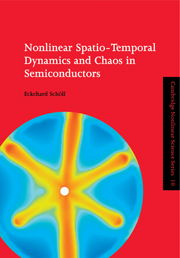Book contents
- Frontmatter
- Contents
- Preface
- Chapter 1 Semiconductors as continuous nonlinear dynamic systems
- Chapter 2 Concepts of nonlinear charge transport in semiconductors
- Chapter 3 Pattern formation and oscillatory instabilities in semiconductors
- Chapter 4 Impact-ionization-induced impurity breakdown
- Chapter 5 Nonlinear carrier dynamics in crossed electric and magnetic fields
- Chapter 6 Stationary and oscillating domains in superlattices
- Chapter 7 Spatio-temporal chaos
- References
- Index
Chapter 3 - Pattern formation and oscillatory instabilities in semiconductors
Published online by Cambridge University Press: 17 September 2009
- Frontmatter
- Contents
- Preface
- Chapter 1 Semiconductors as continuous nonlinear dynamic systems
- Chapter 2 Concepts of nonlinear charge transport in semiconductors
- Chapter 3 Pattern formation and oscillatory instabilities in semiconductors
- Chapter 4 Impact-ionization-induced impurity breakdown
- Chapter 5 Nonlinear carrier dynamics in crossed electric and magnetic fields
- Chapter 6 Stationary and oscillating domains in superlattices
- Chapter 7 Spatio-temporal chaos
- References
- Index
Summary
Self-organized pattern formation is closely connected with negative differential conductivity in semiconductors. In this chapter we develop a general framework for the analysis of the formation and stability of patterns such as current filaments, field domains, and fronts. Special emphasis is placed upon the interaction with an external circuit and the resulting global coupling which strongly affects the stability.
Introduction
In semiconductors, spatially homogeneous states of negative differential conductivity are in general unstable against spatio-temporal fluctuations, which may give rise to self-organized pattern formation. If the j (ε) characteristic is N-shaped (NNDC), such as in the Gunn effect, inhomogeneous electric-field profiles in the form of a high-field domain may arise. If the j (ε) characteristic is S-shaped, such as in threshold switching, the current flow may become inhomogeneous over its cross-section and form a current filament. These spatial structures may be static or time-dependent. In the latter case, current oscillations can arise due to domains moving in the direction of the current flow, or filaments “breathing” transversally to the current flow (Schöll 1987).
At this point a word of warning is indicated. First, negative differential conductivity does not always imply instability of the steady state, and positive differential conductivity does not always imply stability. For example, SNDC states can be stabilized by a heavily loaded circuit (and experimentally observed!), and, on the other hand, the Hopf bifurcation of a limit-cycle oscillation can occur on a j (ε) characteristic with positive differential conductivity.
- Type
- Chapter
- Information
- Publisher: Cambridge University PressPrint publication year: 2001



